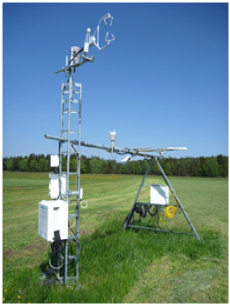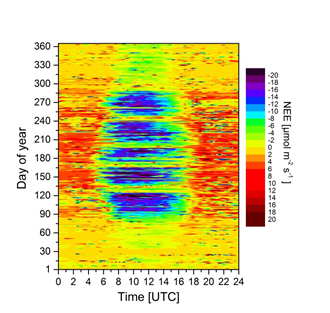Fendt

The Karlsruhe Institute of Technology (Institute of Meteorology and Climate Research-Atmospheric Environmental Research, Campus Alpin) operates four climate- and eddy covariance measurement stations within the TERENO Bavarian Alps/pre-Alps Observatory; three of these sites are also ICOS stations (Graswang, Fendt and Schechenfilz).
Fendt and Graswang are pre-alpine grassland ecosystems in the River Ammer catchment, representing the typical land use in this area. The elevation difference between Graswang and Fendt is about 260 m, leading to natural gradients in temperature and precipitation. These gradients are used in order to gain information about the effects of regional climate change on the greenhouse gas exchange. Furthermore, a lysimeter network is realized (36 lysimeters) at the River Ammer catchment, in which soil monoliths with grassland vegetation are translocated along the existing natural temperature and precipitation gradient, in order to study regional climate change effects on the coupled C and N cycles, the plant biological and microbial processes/populations/ biodiversity involved in C and N-cycling as well as C- and N-trace gas production, consumption and emission.
The intensivly managed grassland (4-6 cuts per year), future ICOS class-1 site Fendt (47.833°N, 11.061°E, 599 m a.s.l) is the lowest located research site in the Ammer catchment with a mean annual air temperature of 8.4 °C and an annual precipitation of 1081 mm. Currently, the site is equipped with a CSAT3 sonic anemometer for 3-D wind measurements and an open-path analyzer LI-7500 for CO2 and H2O flux measurements. In addition a soil-moisture monitoring network has been set up using a wireless sensor network. At Fendt, measurements started in 2010. The vegetation development at the site is continuously monitored by a fish-eye web-cam. Near real-time measurement data can be accessed under http://tereno.imk-ifu.kit.edu/Fendt/.

In 2016 the equipment was supplemented by a closed-path infrared gas CO2/H2O LI7200 gas analyzer and a Gill anemometer HS50 on a second tripod.
The biomass is determined by regular harvesting campaigns. Additionally, TERENO chambers on lysimeters with robot-controlled opening and closing are used to assess greenhouse gas exchange of the plots all year around.
The "fingerprint" shows a typical result of the net CO2 exchange (NEE) between the grassland and the atmosphere. Emissions of CO2 are represented by red and yellow colors, CO2 uptake is represented by green and blue colors. The daily- and annual cycle, as well as the four grass harvests in the year 2011 are clearly visible.